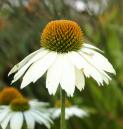Camphor (from Cinnamomum camphora) has been made in China since the earliest record. Marco Polo (518), who visited that country in the thirteenth century, saw many of the trees producing it. It was known to the Chinese writers of the sixth century, as well as were its qualities as a valuable timber. The earliest mention of camphor occurs in one of the most ancient poems of the Arabic language, by Imru-l-Kais, who lived in the beginning of the sixth century. Camphor was once considered as a rare and precious perfume, being mentioned in connection with musk, ambergris, and sandalwood as treasures of the Sassanian dynasty of the kings of Persia. Notwithstanding all this camphor did not, so far as has been determined, reach Europe during the classical days of Greece and Rome. Possibly the first mention of camphor as a European medicine was by the Abbatissa Hildegarde (316), in the twelfth century. Since its introduction, it has always, been an article in domestic medication and as a perfume constituent.
The History of the Vegetable Drugs of the U.S.P., 1911, was written by John Uri Lloyd.

